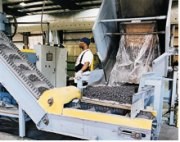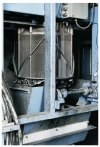Why Use Dip/Spin Coating Technology?
There are a number of reasons to consider dip/spin coating technology...
Three business conditions, one regulatory and two performance related are propelling manufacturers of fasteners, clips and related small stampings to consider the use of dip/spin coating technology. Fitzgerald Finishing, Detroit, Michigan, is one of those companies.
First, environmental regulators continue to focus their attention on plating. Second, the number and volume of applications requiring high coating performance in terms of salt spray, Kesternich rating and consistent torque tension is increasing. Applying a dip/spin coating over thin zinc plate to encapsulate the zinc is an answer that is effective and cost efficient. Salt spray test results can be boosted from a typical 120 to 1,000 hrs using this method. It is also preferable to most alternatives from an environmental perspective. Finally, hydrogen embrittlement is an ongoing concern, and dip/spin has demonstrated an ability to significantly reduce or eliminate this problem.
Dip/spin is a process whereby product is placed in a mesh basket, submerged in coating solution and spun to remove the excess coating. The temperature and viscosity of the coating, immersion time, spin direction and velocities and the cure method are among the variables that allow users to customize a process recipe and achieve precise, highly repeatable results.
Also notable is dip/spin's ability to minimize the cost of both coating material and waste disposal. This is due to the technology's 98 pct or greater on average transfer efficiency.
Dip/spin systems such as those produced by Spring Tools, Portage, Michigan, are most advantageous for small parts with some contours as well as those that can be coated in bulk without adhering to each other. And while there are notable exceptions (one fastener manufacturer fixtures his over-sized bolts for dip/spin processing), optimum process efficiencies are realized with components that are 10 inches or less long and less than two inches in diameter.
While washers and other flat components are more efficiently coated with other techniques, dip/spin is ideally suited to roofing and other construction fasteners, clamps, springs, o-rings, u-bolts, nails and screws, motor mounts and many other devices used for mechanical finishing.
Dip/spin technology is compatible with all major coatings types used in fastener finishing; specifically, coatings that combine high resistance to chemical and galvanic/bi-metallic corrosion with UV stability, anti-galling properties and/or anti-vibration characteristics. Most would also be compatible with sealants, adhesives and locking patches and would be dry to the touch when cured. The specific coating types involved include fluorocarbons, zinc-rich, ceramic metallics (aluminum-based with organic or inorganic topcoats) and waterborne systems.
The dip/spin process encompasses three steps: 1) Cleaning and pretreatment; 2) Coatings application; and 3) Cure. Fastener manufacturers typically use a grit of 80- to 100-mesh aluminum oxide to remove oxides and heat treating scales. Micro-, medium- or heavy-crystalline zinc phosphate is the favored pretreatment where needed, although there are several dip/spin coatings that can be applied over bare steel.
After drying, parts are loaded into a wire-mesh lined basket. If loading is automatic, the system conveys parts to a weigh scale hopper with pre-set batch weights. After loading, parts are transferred into the dip/spin chamber and onto a rotating spin platform where they are locked in place. The coating container, positioned directly below, is then raised to submerge the basket of parts in the coating.
When immersion time is complete, the coating container drops to a point where the basket is still in the container, but above the liquid level. The basket is then centrifuged.
A common spin cycle would be one direction for 20 to 30 sec, a full brake, then reverse spin for an equal duration. The braking action re-orients parts to most efficiently remove coatings from recesses. When dip/spin is complete, the coating vessel is fully lowered and the basket is realigned, unlocked and removed. Re-loading occurs and the process is repeated.
Coating material is placed in a steel vessel and inserted and removed through a side access door. Color changes are accomplished in 10 to 15 min by simply removing the original coating vessel and basket and replacing them with new ones. Coatings are stored in the dip/spin container, which is sealed with a metal or polyethylene lid. Mesh baskets are cleaned using solvent soak or grit blast or the mesh liner alone is processed in a burn-off oven.
A few coatings used in fastener finishing air-dry. For the 90 pct plus that require heat, smaller dip/spin lines incorporate a batch oven; larger equipment incorporates a conveyorized belt oven. Conveyor belts are sized to the parts. Coated parts are loaded directly onto the oven belt and spread manually over the width. Or, they are unloaded onto a vibratory tray that spaces parts over the oven belt automatically.
Cure cycles range from five to 30 min; ideal peak metal temperature is 149 to 316F. A forced-air cooling station brings product temperature back to near ambient.
Dip/spin equipment is manufactured in sizes scaled to process requirements. Where product batches are small and many color changes are needed, a small system, with a 10-inch diameter basket, a 750 lb/hr capacity and rotational speeds from zero to 900 rpm would be recommended. This type of system will accommodate manual operation, where the operator loads the basket and operates the dip and spin portions of the cycles using hand valves or partial automation where loading/unloading is manual, but cycles are PLC-controlled.
A mid-sized machine, suitable for most job shops uses a basket 16 inches in diameter with a usable volume of one cu ft. Capacity is approximately 150 lbs. This system would typically process up to 4,000 lbs/hr of product and a spin speed of up to 450 rpm.
The largest fastener manufacturers and finishing job shops are generally best served with a system using a 24-inch diameter basket and having spin speed of up to 400 rpm.
Related Content
Henry Ford Is Still Right When It Comes to Color
Who would have imagined that more than 100 years after his famous statement about any color as long as it’s black would still have relevance of a sort?
Read MoreCoatings Plant Evolves with Market Trends
Expanding its focus from exclusively serving the RV industry, one of this company’s stand-alone coatings plant has successfully extended its services to additional markets.
Read MoreShedding Light on Surface Inspection
State-of-the-art reflector-based lighting system improves luminosity and ergonomics for surface inspection tasks while reducing energy usage.
Read MoreZinc Phosphate: Questions and Answers
Our experts share specific questions about zinc phosphate and pretreatment
Read MoreRead Next
Education Bringing Cleaning to Machining
Debuting new speakers and cleaning technology content during this half-day workshop co-located with IMTS 2024.
Read MoreEpisode 45: An Interview with Chandler Mancuso, MacDermid Envio Solutions
Chandler Mancuso, technical director with MacDermid Envio discusses updating your wastewater treatment system and implementing materials recycling solutions to increase efficiencies, control costs and reduce environmental impact.
Read MoreDelivering Increased Benefits to Greenhouse Films
Baystar's Borstar technology is helping customers deliver better, more reliable production methods to greenhouse agriculture.
Read More














.jpg;maxWidth=300;quality=90)









